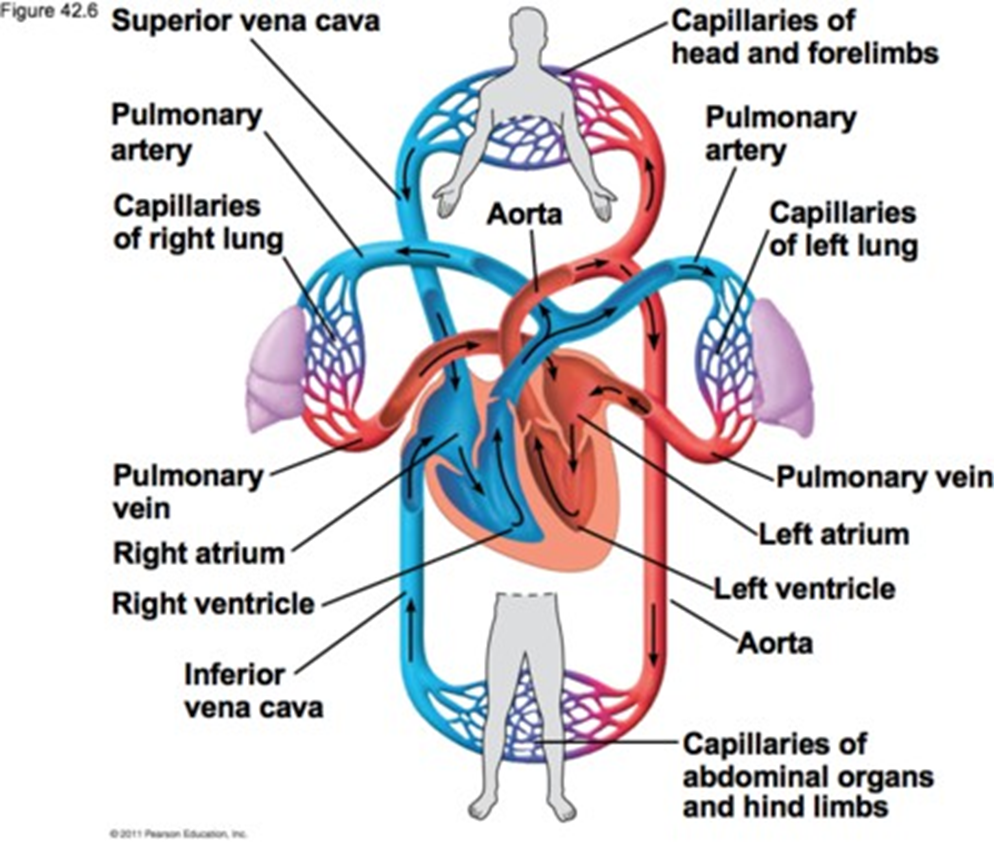Which sequence best describes the direction of blood flow through the heart and lungs?
Vena cava → Right atrium → Right ventricle → Lungs → Pulmonary artery → Left atrium → Left ventricle.
Right atrium → Right ventricle → Pulmonary vein → Lungs → Pulmonary artery → Left atrium → Left ventricle.
Right atrium → Right ventricle → Pulmonary artery → Lungs → Pulmonary vein → Left atrium → Left ventricle.
Right atrium → Right ventricle → Lungs → Pulmonary vein → Pulmonary artery → Left atrium → Left ventricle → Vena cava.
The Correct Answer is C
Choice A rationale
This sequence is incorrect because it suggests that blood goes from the lungs to the pulmonary artery, which is not accurate. The pulmonary artery carries deoxygenated blood from the heart to the lungs.
Choice B rationale
This sequence is incorrect because it suggests that blood goes from the pulmonary vein to the lungs, which is not accurate. The pulmonary vein carries oxygenated blood from the lungs to the heart.
Choice C rationale
This sequence correctly describes the direction of blood flow through the heart and lungs. Deoxygenated blood enters the right atrium, goes to the right ventricle, then is sent to the lungs via the pulmonary artery. After picking up oxygen in the lungs, the blood returns to the heart via the pulmonary vein, entering the left atrium, then the left ventricle, from where it is pumped out to the rest of the body.
Choice D rationale
This sequence is incorrect because it suggests that blood goes from the pulmonary vein to the pulmonary artery, which is not accurate. The pulmonary vein carries oxygenated blood from the lungs to the heart, and the pulmonary artery carries deoxygenated blood from the heart to the lungs.

Nursing Test Bank
Naxlex Comprehensive Predictor Exams
Related Questions
Correct Answer is C
Explanation
Choice A rationale
Reducing the overall contractility of the heart muscle is not the primary reason for performing Coronary Artery Bypass Surgery (CABG)4. In fact, reducing the contractility of the heart muscle could potentially decrease the heart’s ability to pump blood effectively.
Choice B rationale
Reducing plaque buildup in the carotid artery is not the primary reason for performing CABG4. While plaque buildup in the carotid artery can lead to serious conditions such as stroke, CABG is specifically performed to bypass blocked coronary arteries, not carotid arteries.
Choice C rationale
Increasing the oxygen supply to the heart muscle is the primary reason for performing CABG4. When coronary arteries become blocked or narrowed due to plaque buildup, the heart muscle may not receive enough oxygen-rich blood. CABG is performed to create a new route, or bypass, around the blocked artery, which improves blood flow and oxygen supply to the heart muscle.
Choice D rationale
Increasing the myocardial workload is not the primary reason for performing CABG4. In fact, increasing the workload of the heart could potentially exacerbate heart disease and lead to complications such as heart failure.
Correct Answer is C
Explanation
Choice A rationale
Adenosine (Adenocard) is a medication that can be used to treat supraventricular tachycardia, a type of abnormal heart rhythm. However, it is not typically used for atrial fibrillation.
Choice B rationale
Emergency cardioversion, where an electric shock is used to restore the heart’s normal rhythm, can be used in some cases of atrial fibrillation. However, if the atrial fibrillation has been present for more than 48 hours, there is a risk of blood clots, and anticoagulation for several weeks before the procedure may be needed.
Choice C rationale
Anticoagulant therapy is often used in patients with atrial fibrillation to reduce the risk of stroke. Atrial fibrillation can lead to blood pooling in the atria, increasing the risk of clot formation. These clots can then travel to the brain, causing a stroke.
Choice D rationale
Permanent pacemakers are sometimes used in atrial fibrillation to help regulate the heart’s rhythm. However, they are typically used when other treatments have failed or are contraindicated.
Whether you are a student looking to ace your exams or a practicing nurse seeking to enhance your expertise , our nursing education contents will empower you with the confidence and competence to make a difference in the lives of patients and become a respected leader in the healthcare field.
Visit Naxlex, invest in your future and unlock endless possibilities with our unparalleled nursing education contents today
Report Wrong Answer on the Current Question
Do you disagree with the answer? If yes, what is your expected answer? Explain.
Kindly be descriptive with the issue you are facing.
